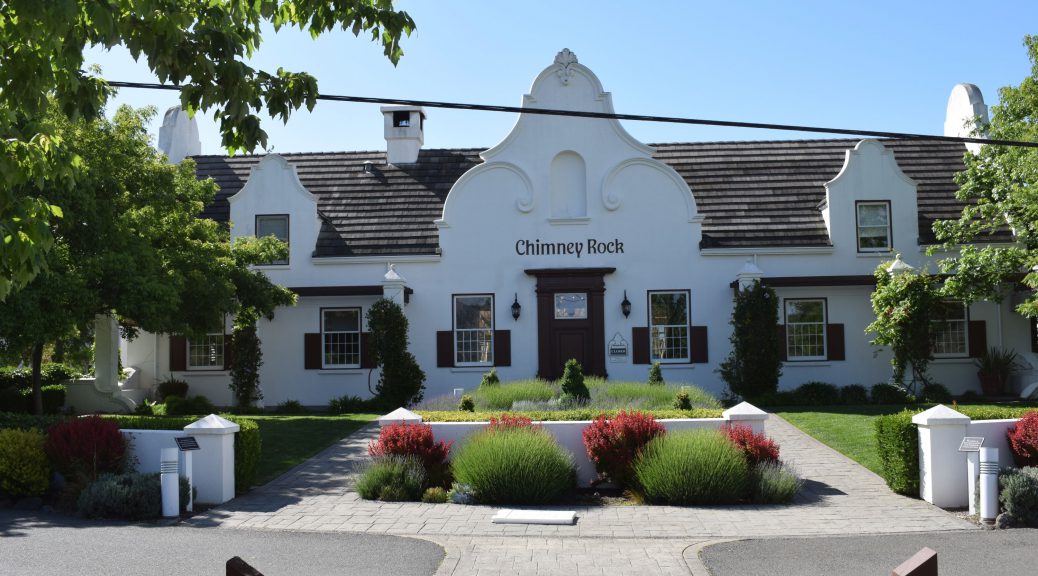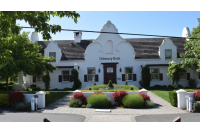
Chimney Rock
Most winemakers have an affinity with their vineyards. Most will extol their virtues and pay homage to them. And others go a little further. But Elizabeth Vianna is in love with her vineyards.
She stands before the Ganymede vineyard right outside the winery at Chimney Rock and describes Ganymede and its neighbours, including Tomahawk, Clone 4, and the fantastically named Cardiac Hill, with a reverence that borders on poetry.
The story of Ganymede is interesting because it has a planting regime that I’ve not encountered before. Initiated by Elizabeth’s predecessor, Doug Fletcher, Ganymede is planted on an asymmetrical trellising system named the Fletcher Lyre. In this system, one side of the trellis is planted a few inches higher than the other side, which ensures fruit from both sides of the vine ripens at the same pace.
Situated on the famed Silverado Trail in Napa Valley’s renowned Stags Leap District, Chimney Rock was established in 1984 with the goal of creating wines that would compete against the best Bordeaux. All the vineyards in the 131-acre site are within a quarter mile of each other, but each has its own unique terroir, creating 28 distinct vineyard blocks on the property.
“So if you look at Tomahawk and Alpine, they are 100 yards from each other, but they are chalk and cheese. Yin and Yang, if you may.”
Elizabeth became head winemaker at Chimney Rock in 2005 and has also served as President of the Stags Leap District Winegrowers Association. Self is effacing, yet obviously a star. She startles us when she tells us that her husband was born in Burnley.
“Burnley in England?”
“Yes.”
Which you don’t expect when you are discussing wine on the Silverado Trail. Also, her husband’s father was Frank “Tiger” Hill, who played professionally for Arsenal and Scotland. He apparently got his nickname from the way he tackled.
This provides a humorous distraction when swirling a beautiful Elevage Blanc 2020 round the glass. The wine—78% Sauvignon Gris, 22% Sauvignon Blanc—has stylish fruit, a touch of spice and cardamom, and a beautiful texture in the mouth.
As you might expect, Elizabeth is keen to promote sustainability. “We do not use technology to bypass Mother Nature.” She is aiming for a net irrigation deficit in the vineyards; the winery is Green Certified by the California Land Stewardship Institute; they are 100% solar powered; they have Integrated pest management; they use cover crops planted between vineyard rows to help improve soil health; they foster predatory bird inhabitants to help with rodent control. (It often amuses me to learn how much of a nuisance in these parts are gophers – friendly-looking mole-like chappies.)
You can’t help but chuckle when you hear Elizabeth describe her babies. The youngest wines are aged in the Nursery barrel room before being moved to the Teenager barrel room. Wines from the Alpine vineyard are unruly students running off in all directions, whereas Ganymedes are quieter, more reflective students.
We taste the Elevage Rouge 2020: dark, dense, broody fruit. I sense a lot of rhubarb-type Cabernet Franc, but I am surprised to learn it contains only 3% (as against 40% Cabernet Sauvignon, 39% Merlot, and 18% Petite Verdot).
As we move on, Elizabeth explains that she uses only free-run juice in the Chimney Rock-labelled estate wines.
The Estate Cabernet Sauvignon 2018 has supple, inviting fruit on the nose. Masses of currants, red and black. Lovely integration of soft oak tannin. Beautifully balanced.
The Alpine 2016 has an epic nose: dark chocolate, black plums, and tobacco. It is sensuous and silky, with a touch of anise on the palate. It is delicious.
The Ganymede 2016 is softer and more delicate than the Alpine. It has red fruits, a lovely balance on the palate, and a lovely soft aftertaste.
“I’m not a fan of high-alcohol wines,” says Elizabeth. “When I started, everyone wanted high alcohol, power, dark, inky wines, and ripeness. But how much ripeness do you need? We lost freshness in favour of power. So we’ve been returning to the middle for a long time.”
I love that expression: going back to the middle.
The Ganymede 2018 is pure Bordeaux with silky smooth tannins, cigar box, and blackcurrants. Soft tannins.
The Clone 4 2018 is more extreme. It has dark, heady black fruit and firm tannins. “Small berries,” explains Elizabeth.
The Estate 2018 is serious fruit: pure black fruit, tobacco, and cedar, with ripe tannins and a very soft texture.
As we conclude a superlative tasting, we all agree that the wines have supreme balance, a lovely combination of freshness added to the unmistakable structure of Napa fruit.
What would Frank “Tiger” Hill make of all of this?
Chimney Rock Napa Valley Elevage Blanc 2022
Chimney Rock Tomahawk Stags Leap District Cabernet Sauvignon 2019



